
Chris Parker, Jim Nowell and I said goodbye to Bob Riskie, who was off to downtown Portland to rent a car for his drive to Eugene and Bend. The now "Amazing Three" drove to Elmer's for breakfast before making our way to Hood River but stopped at Multnomah Falls where Chris had his first good look at the fabulous falls.


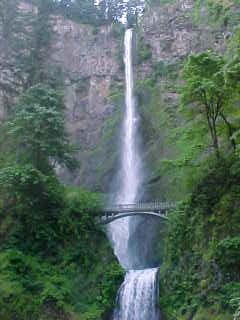


Multnomah Falls. Spanning two tiers on basalt cliffs, it is the tallest waterfall in the state of Oregon at 620 feet. The Multnomah Creek Bridge, built in 1914, crosses below the falls and is listed on the National Register of Historic Places. The land surrounding the falls was developed by Simon Benson in the early-twentieth century, with a pathway, viewing bridge, and adjacent lodge being constructed in 1925. The Multnomah Falls Lodge and the surrounding footpaths at the falls were added to the National Register of Historic Places in 1981. Contemporarily, the state of Oregon maintains a switchback trail that ascends to a talus slope 100 feet above the falls, and descends to an observation deck that overlooks the falls' edge.
Once at Hood River we stopped for twelve dollars of petrol before driving over to the Mount Hood Railroad station, where we all bought caboose tickets and waited to board the train, which reversed into the station with GP38 02, MH open car 1056 "Lookout Mountain", MH coach 1060 "Odell", MH concession car 1080 "Timberline", MH coach 1070 "Katherine" and MH caboose 1040.
Mount Hood RailroadIn the early to mid 2000's, Mount Hood Railroad was a privately-owned passenger excursion railroad that ran along 22 miles of track between the city of Hood River, Oregon and Parkdale, Oregon. This shortline used to serve several large mills and local industry and interchange with the Union Pacific mainline in Hood River, but that changed when some of the mills closed down and freight service dramatically decreased. This almost 100-year-old railroad, now is used almost exclusively as a passenger tourist line, although it has the capacity to continue to serve as a reliable freight short line to the UP mainline, if any customers so desired.
The history of the Mount Hood Railroad dates as far back as the 1880s. That is when the Oregon-Washington Railroad and Navigation Company built the mainline from Wallula, Washington, west to Portland, Oregon, passing through Hood River. It was then that the first depot in Hood River was built. But in about 1905, it was decided that a railroad would be built south, out of Hood River into the interior and mountains to serve as a logging railroad. The line was incorporated as the Mount Hood Railroad. To make the steep climb from the Columbia River to the mountains, the railroad built a switchback which is still used today. This was a common feature on logging railroads of old, but virtually unheard of on existing railroads today.
In 1911, the original depot in Hood River was torn down and the current depot, which still exists today, was built. That depot was meant serve both the Mount Hood Railroad and the Union Pacific mainline and was located right at the interchange. There was also a depot located in Parkdale. In 1968, Union Pacific acquired the short line, but it retained the Mount Hood name and equipment. In 1987, a private local group purchased the line from Union Pacific and has been running it ever since. If not for this private investment, it's very likely that the line would have gone the same way as the other Union Pacific shortlines that ran into the interior, east of here, and been abandoned and torn up. In 2002, the Federal Railroad Administration, loaned 2.07 million dollars to the Mount Hood Railroad, mostly for track rehabilitation.
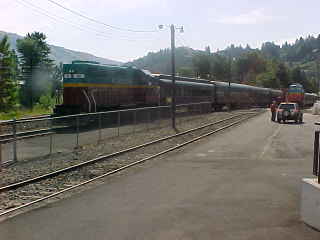
We boarded the caboose by walking through the train. Philip Kondziela, who had been on the Camp Six trip, also joined us.
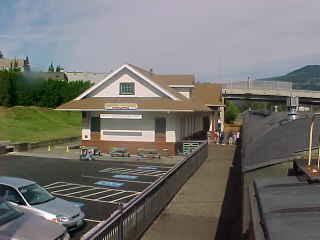
Union Pacific Hood River station built in 1911 as seen from the cupola.
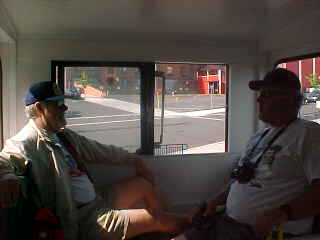
Jim and Chris in the cupola.

The Union Pacific mainline to the left and our route to the right.

Reversing up the mainline to the switchback.

Reaching the switchback with the upper level to the left.

Heading up the 38 car tail track.

With our engine now pulling, we made our way up the upper level of the switchback at Milepost 2.5 and 307 feet in elevation towards Parkdale.

Crossing the highway bridge on a big curve.

Looking back through the forest.

Mount Adams in Washington across the Columbia River.

Mount Hood.

A look back at Mohr at Milepost 6.8.
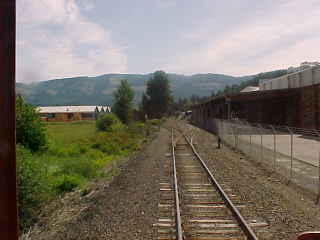
A look back at Lentz at Milepost 7.5.

Clouds attack Mt Adams.

The view down the grade.

Passing through the forest.

Cresting another step towards Parkdale.

Mount Hood.

The train passing through Dee at Milepost 15.5.

Further south, Mount Hood.

Mount Hood.

The train takes a curve near Trout Creek.

Through the forest on a steady climb.
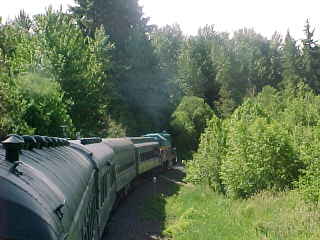
Curving near Camp 1.

Mount Hood from Woodworth.

Mount Hood nearing Parkdale.

Mount Hood at Parkdale.
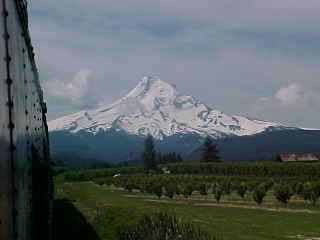

At Parkdale, Milepost 21, at 1,788 feet elevation, our engine ran around the train before pushing us into the station. We detrained and went across the street to have lunch at the Rail End Café. The Mount Hood Railroad came to small upper valley town in 1910 through the vision of two men, David Eccles, the builder of the railroad, and R.J. McIsaac, an Iowan who came to the upper valley in 1902.

The Parkdale sign.

The train at Parkdale with Mount Hood covered in clouds.


Mount Hood Railroad GP38 02, ex. Point Comfort and Northern Railway Company 16, exx. Conrail 7796, nee Penn Central 7796 built by Electro-Motive Division in 1969.
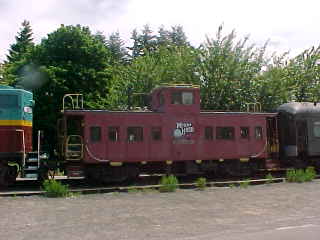
Mount Hood Railroad caboose 1040, ex. Union Pacific 25249 1959, nee Union Pacific 3949 built by the railroad in 1952. It was retired in 1986 and sold to Mount Hood Railroad shortly thereafter.
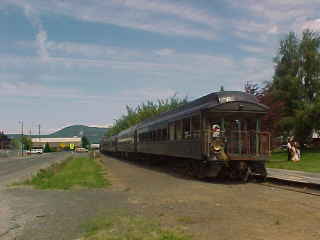
The rear of our train at Parkdale.

The Mount Hood Mack railbus, built in 1921 for the Willamina & Grande Ronde Railroad, where it operated in passenger service up until 1928. It was then sold to Condon, Kinzua and Southern, where it hauled passengers, mail and express from then until 1951. It was re-built with a new body in the late 1940's and nicknamed "The Goose" while in service on the CK&S. It was then part of Trolleyland Electric Railway Museum in Olympia Washington, sometime after 1951, with the car placed on display in Fossil, Oregon for the town's 75th anniversay celebrations. It was displayed in front of the Wheeler County Courthouse in Fossil for many years before ownership ended up in the hands of the Mt. Hood Railroad. It passed through the Mt. Rainier Scenic Railroad before being placed on display by the Mount Hood at Parkdale, under the mistaken belief that the car had once worked on that railroad. It has since moved to Willamina.

Jim on the open platform of Mount Hood Railroad open car "Lookout Mountain", nee Southern coach 1595 built by Pullman Company in 1923. Chris had arranged a cab ride back to Hood River for the two of us and soon we were welcomed into the cab of 02.

On the move we passed the Parkdale sign before going into the siding.

We waited for the Mount Hood Railroad Brunch Train.

Exiting the Parkdale siding.

Curving near Woodworth.

Nearing Woodworth.

Woodworth at Milepost 19.5. For fifty years, fruit and lumber left for market from this spot and a busy depot stood at this crossing.
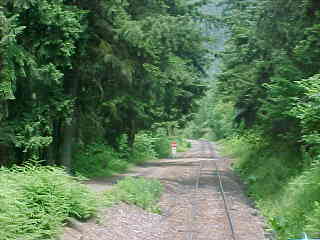
Nearing Camp No. 1 at Milepost 18.5 A loading platform for the magnificent old growth logs cut on the Oregon Lumber Company land stood here in the early 1900's. As the huge trees were cut, company yarders pulled the stumps, clearing the land for planting and settlement.

Rolling down grade through the forest.

Trout Creek at Milepost 16.7. A passenger shelter stood south of the tracks near the Dee highway crossing. After following the East Fork for a short distance, the train begins to climb away from the river, coming out on an alluvial plain first formed by mud flows and debris from Mount Hood's Eliot Glacier during the Ice Age.

Me in the fireman's seat of the locomotive.

Milepost 16.

The Hood River.

Passing through Dee.

Dee at Milepost 15.5. The Oregon Lumber Company had been looking for a mill site closer to their timber holdings on the foothills of Mount Hood and the alleys below. Finding this spot, they constructed the railroad, reaching Dee in 1906, moved the mill from the banks of the Columbia and built a town. The mill town was named for Judge Thomas D. Dee of Ogden, Utah, a vice-president of the company.

Passing the old mill lake at Dee.

Winans at Milepost 14.5. The Winans family, who came to this area in 1897, operated a three-storey hotel where tourists came to enjoy fishing, hunting and picnicking near the popular Punchbowl in the Hood River. A small active sawmill is located nearby operated by descendants of the original family.
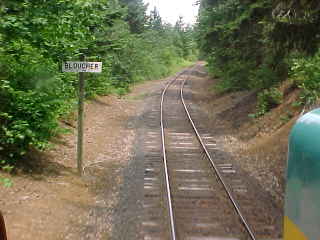
Bloucher at Milepost 11.7. The station was located just north of the highway crossing.
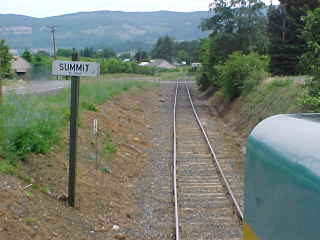

A few minutes later we reached Summit at Milepost 10.5. A freight and passenger depot stood at this crossing of Gilhouley Rod, now marked by a schoolbus shelter. Near this spot in 1935, the current Galloping Goose, a 1922 Mack Railbus, burned.

Rolling down the steep grade.

Dukes Valley at Milepost 9.4. Originally passengers were carried on the steam train but from 1916 to the end of regular passenger service in the early 1940's, a succession of jitneys, each known locally as "the Galloping Goose" ran on the tracks carrying passengers and mail only.

Odell at Milepost 8.5. The town was named for William S. Odell, who came to the area from California in 1861. A Hudson's Bay Company trail from The Dalles to Fort Vancouver crossed this flat in the early 1800's and long before that, it ws known as a gathering place for the native people of the area.

Lentz at Milepost 7.5. Lentz station was originally known as Sherman Spur and later named for a family who came to the valley in the early 1880's.
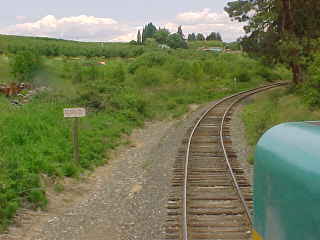
Mohr, Milepost 6.8. In the early days, a simple shelter protected waiting passengers at this crossing of Ehrck Hill Drie where the Mohr packing house was located. It was named for a pioneer family of the 1880's, whose descendants continue to live in the area.

The train continued down the steep grade.

Just past Mohr, we spotted a trespasser on the track, who panicked. He did an end-over-end down the ballast and landed on his face. Today's lesson is "Always stay off railroad tracks!"
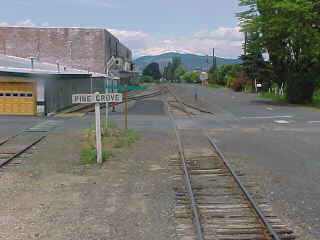
Pine Grove, Milepost 5.6. The train runs past a Diamond Fruit installation on the north side of Van Horn Drive, passes between the busy Pine Grove Grange Hall and Duckwall-Pooley's main plant on the south side, and near the Dominguez Family tortilla factory.

A tank car being loaded.


The curved bridge over Oregon Highway 35.

Our train on that bridge.

Rolling down the upper level of the switchback.
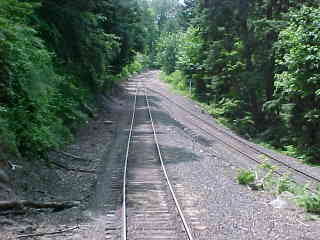
Arriving at Switchback at Milepost 2.5.

Switchback. In order to climb the steep side of the Hood River gorge, the original builders of the Mount Hood Railroad installed a turntable at the spot. In the old days of steam, it was necessary to keep the engine headed forward to maintain the water level over the crownsheet of the steamers. When the railroad changed from steam to diesel in 1950, the turntable was no longer required and a simpler 13-car switchback was installed here. After acquiring the railroad in 1968, Union Pacific extended the switchback to hold 18 cars.
One of the few remaining switchbacks in the country, this feature gives the Mount Hood its nickname, "The Backwards Railroad". This was also one of several locations for the crank-type telephones used for communications in the days before the Union Pacific installed radios.

Going down the tail track.

Leaving Switchback with us now pushing the train down to Hood River.

Looking back at Switchback.

Mount Hood Railroad 02 now pushing our train.

The view looking back upgrade.

Another view back.

The large water pipe near Powerdale.

Powerdale at Milepost 1.0. Electricity came to Hood River in 1901 when the Hood River Light and Power Company built a 50 kilowatt generating plant on the river. In 1904, a rival company built a plant at this site (Powerdale) and by 1906, local developers advertised "a number of excellent locations for manufacturing establishments" with this bountiful supply of electricity. Pacific Power and Light acquired the Powerdale plant in 1911, replacing it in 1923 with the current building.
Beyond the plant, the railroad follows the huge penstock or pipeline that carries water to the generators from a dam upstream. Early trainmen told of leaks in the wooden pipe causing ice that had to be hacked from the tracks before the train couuld pass. Steel now has replaced most of the wooden pipe. Once providing all the electricity for the area, the plant furnishes only a minute portion of the power needed by Hood River businesses and homes today.

Pushing below Powerdale.

About to cross the Hood River.

Hood River at Milepost 0.2. Indians called the river "The Place of the Cottonwoods" and were known as the Dog River band of the Chinookan-speaking Wasco Indians, whose descendants now live on the Warm Springs and Yakima Reservations. Lewis and Clark wrote of seeing four native houses near this spot on October 29th, 1805.
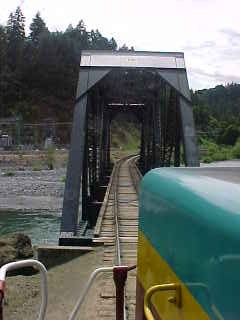
The Hood River bridge.

The former mill water tower.

Rolling down grade along the Hood River just outside of town.

We returned to Hood River and thanked our engineer for a great and interesting trip, after which I walked up to the street bridge above the station.

Our train in front of the Hood River Station.

Back on the ground, our train at rest.

Mount Hood Railroad GP9 89, ex. Minnesota Valley 306, nee Milwaukee Road 306 built by Electro-Motive Divison in 1959. That ended our wonderful trip on the Mount Hood Railroad and we drove across the Columbia River on the Hood River toll bridge into Washington, going east through Bingen to a spot along the Columbia River to set up for a possible picture.

As we were waiting, an Aquaculture Transport barge was on its way west. A pair of Union Pacific freights kept Chris and I entertained.

Finally an eastbound BNSF freight came by en route to Pasco. A green signal was displayed for the picture we really wanted, but we ran out of time and drove back to the Portland International Airport, where we dropped Chris off as he had an earlier flight. We then returned the rental car and learned that we had driven 612 miles.
Alaska Airlines Flight 500When I went to get my boarding pass at the counter, I had no seat assignment so produced the e-mail I received when they rescheduled my flight in April, showing I had seat 9A. The agent gave me seat 11A, I was happy and she apologized for the mistake and said I was now set. I had never had a bad flight with problems before and thought everything was all right. The three of us had dinner at Stanford's before going through security together. Chris' flight for Los Angeles boarded at 6:30 PM and we said our goodbyes to him just before he boarded.
Jim and I waited for our flight to Orange County. Just before I was to board, they called "Mr. Guenzler, see us at the counter". My seat had been changed from a window to a middle seat and I was very upset after being told just over an hour before that I was all taken care of. First, a schedule change, then being rebooked on a different flight to get here, followed by an e-mail confirmation showing I had the same seats really shows just how badly airlines are run. If I have a Business Class seat on a train, there has always been a seat for me. The airlines' practice of overselling flights is so stupid to me!
The gate agent, seeing that I was very upset, walked me to the front of the line of people boarding the plane. As I was putting my bag in the overhead luggage compartment, the flight attendant shut the door on my hand. I could not believe this flight. I sat in seat 8B and wondered what would happen next. The plane took off at 8:10 PM, I read most of Trains Magazine and we touched down at 10:23 PM, taxiing to Gate 10, where we sat for the next fifteen minutes until the ground crew could get a gangway to the plane. That made this the worst flight that I had ever had and decided to contact Alaska Airlines about my experiences.
I was glad to be off the plane as we walked out front to wait for Jim's wife, Julie, to pick us up and drive me home. Thus ends an excellent trip on the ground with plenty of new events that I truly enjoyed.
| RETURN TO THE MAIN PAGE |